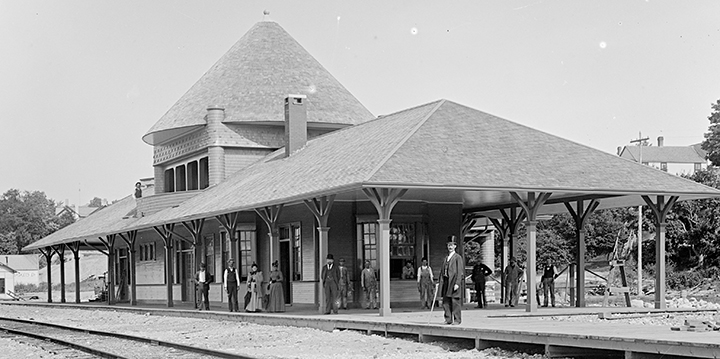
Petoskey’s old train station, which now serves as a museum. Photo: Little Traverse Historical Society.
The newest book by historical author Michael Federspiel explores the evolution of Michigan’s Little Traverse Bay area, home to the small towns of Petoskey and Harbor Springs. The towns began to boom as the area embraced a tourist-friendly identity, but surprisingly, many streets, buildings and community traditions have stayed firmly close to their origins of well over a hundred years ago.
Comparing historical society photographs with the modern-day photographs of Rebecca Zeiss, the book shows the striking development — and sometimes even more striking similarities — within Little Traverse Bay.
Federspiel spoke with Great Lakes Echo about the past, present and future of this cherished area of Northern Michigan.
GLE: So much of the bay’s natural beauty has remained unchanged and in some places, there are more trees and plants and better waterfront access — how unique is that for development to go hand-in-hand with natural preservation?
MF: I don’t know that it’s particularly unique to the bay, but places like Little Traverse Bay are so stunningly and naturally beautiful that it brings people back year after year after year. That preservation is purposefully done. The local community makes a great effort to preserve the area.

Photo: Wayne State University Press.
GLE: You wrote that Petoskey isn’t unchanged, but it’s still very recognizable. Can you describe how?
MF: The town is, always has been and always will be changing. Even from the time that the modern photographs were taken [by photographer Rebecca Zeiss], things are still different. It’s a natural and healthy evolution to see that happen. But oftentimes, certain things get to a point where they’re old enough and majestic enough that you just can’t change them and that’s part of the identity. It’s interesting, once you know the history of a place to be able to see the construction of a place and you see the identity.
GLE: Natural beauty is a huge tourist draw, but the bay also looks like such a pleasant and welcoming place to bike through and to walk through. How does that accessibility factor into modern Little Traverse Bay’s tourism industry?
MF: Accessibility is huge. One of the things with Petoskey is that the waterfront was largely industrial until the 1980s, was a series of brownfield spots. In the 1980s, we started to have some interest by developers to put condominiums right on that lakefront. That land was available — it just needed to be cleaned up.
The city recognized in a hurry that the lake was a resource for everybody — and not just for people who could afford to live on the waterfront. That’s when you saw the waterfront turn into park land. The old rail line that goes around the bay — the old dummy train line — is now a bike path that gives people the opportunity to go down to the water and go see the water. Harbor Springs has such a delightful waterfront, and that waterfront should be everyone’s place.
You see people that are simply drawn to the water and drawn to the sunsets. There’s a phrase coined in the early days of Petoskey: ‘Million dollar sunsets.’ And it’s true. People still gather nightly around the water because now it’s user-friendly, handicap accessible, with benches. It’s designed that way to be accessible for the year-round people and the people who visit but still feel very much a part of the community.
GLE: If you had to speculate, how would you envision the next 50 or 100 years of development to look like on Little Traverse Bay?
MF: The path to the lakes, the sunsets — that’s still going to be the focus. The arc we’re seeing is an understanding locally of how important it is to preserve nature and character — not only economically, but to identify who and what we are here. In fifty years, I think we’ll see more and more land set aside. I think we’ll see even more bike paths and walkways that benefit our local people as well as our guests. And I think we’ll see the tourist industry reinvent itself, but still maintain its historical purpose and its identity.
